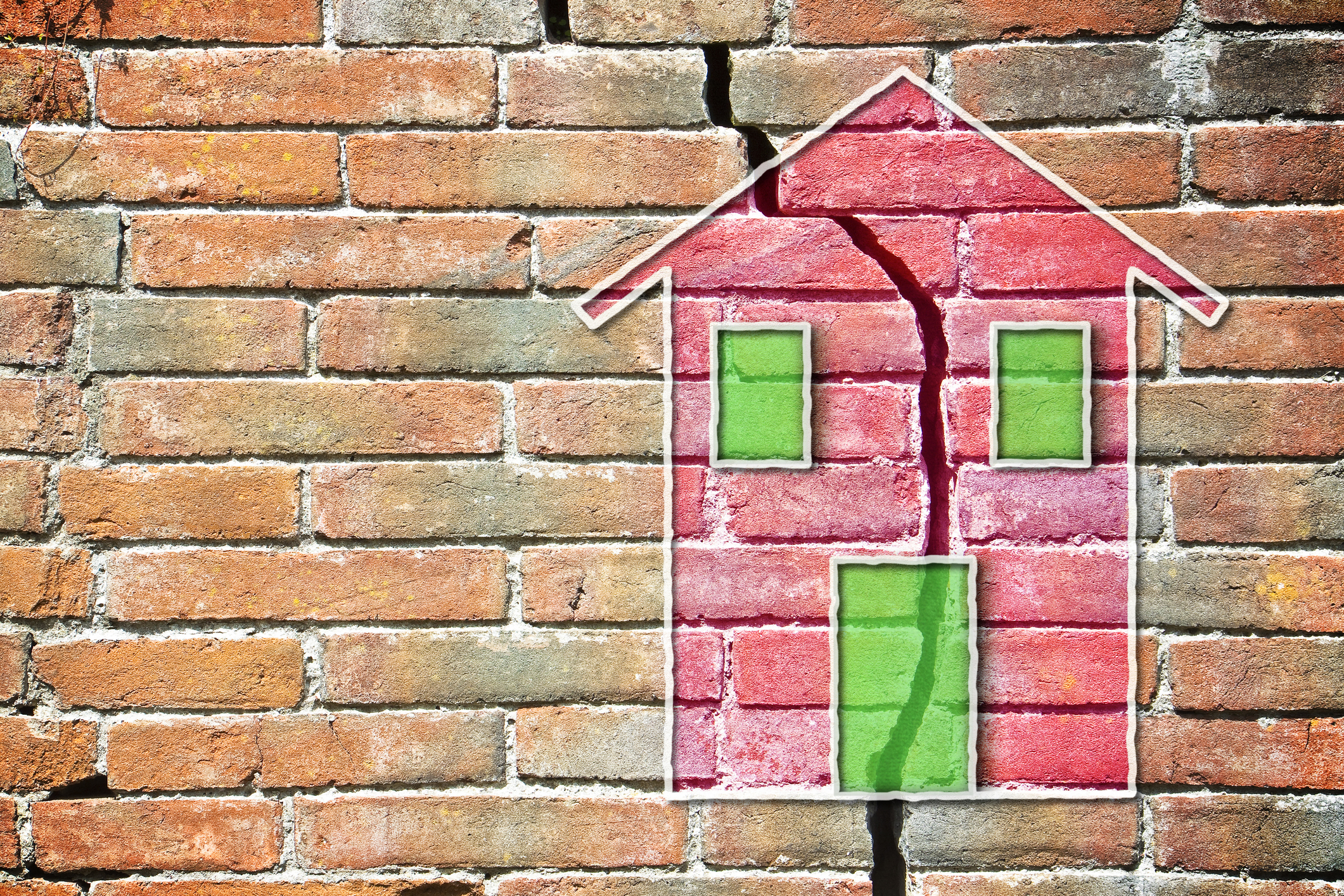Thousands of homeowners claim £17k for subsidence amid heatwaves – how to spot the signs
Insurers have paid out £150 million for subsidence so far this year. But more than half of people don’t know what to look out for to make a claim.


Thousands of property owners have claimed on their insurance for subsidence in the first half of the year, according to new figures, as record temperatures wreak havoc with building foundations.
Over the first six months of the year, insurers paid out £153 million to almost 9,000 households to help them recover from subsidence damage, the Association of British Insurers (ABI) said, with the average insurance payout per claim standing at £17,264.
Making a claim can send your insurance premiums higher. But there are ways to cut the cost of home insurance.
MoneyWeek
Subscribe to MoneyWeek today and get your first six magazine issues absolutely FREE

Sign up to Money Morning
Don't miss the latest investment and personal finances news, market analysis, plus money-saving tips with our free twice-daily newsletter
Don't miss the latest investment and personal finances news, market analysis, plus money-saving tips with our free twice-daily newsletter
Subsidence occurs when the ground beneath a building sinks, pulling the property’s foundations down with it. It typically happens when soil loses moisture and contracts – often due to extended dry spells or the presence of trees and shrubs that draw water from the ground.
The ABI’s figures follow unusually high spring temperatures, with the Met Office confirming the UK experienced its warmest spring on record this year – with above-average temperatures across all four nations.
We look at the cost of air conditioning to help with the heat in a separate article.
Louise Clark, manager of general insurance policy at the ABI, said: “Climate change is significantly increasing the risk of subsidence in the UK, particularly in areas with clay-rich soils that sink and swell in response to changing moisture levels caused by hot temperatures.
"If you suspect your property has suffered from subsidence damage, contact your insurer as soon as possible. It’s exactly what your home insurance is there to cover.”
How to spot subsidence
When it comes to spotting subsidence, understanding the signs is key. These include:
- Distinctive diagonal cracks appearing at the edges of windows and doors, usually wider at the top than the bottom and around 3mm thick or thicker than a 10p coin.
- Doors or windows sticking for no reason, or closing easily in winter but not summer.
- Tearing wallpaper which is not caused by damp.
However research by LV General Insurance that quizzed 2,002 UK adults, including 1,318 homeowners, on their knowledge of subsidence found widespread confusion – 51% of homeowners don’t know what to look for when it comes to the common property problem.
While almost three quarters of people (71%) correctly identified large cracks in walls as a key sign of subsidence, almost a third (30%) of people incorrectly guessed tilting trees outside the home was an indicator.
The table below shows what percentage of people guessed which potential signs of subsidence – and if they were right or not.
TRUE (signs of subsidence) | FALSE (not signs of subsidence) |
|---|---|
Large cracks in walls (indoor and exterior) – 71% | Tilting large trees outside the home – 30% |
Sinking foundations or sloping floors – 68% | Bulging floorboards – 28% |
Sinking or dips in pathway or driveway – 53% | Damp patches appearing – 13% |
Doors and windows difficult to open or stick – 48% | Signs of mould – 9% |
Wallpaper tearing (with no signs of damp) – 25% | Musty odour – 8% |
Top tips to help prevent subsidence
There are some steps homeowners can take to prevent subsidence. These include:
- Pruning trees and large shrubs to prevent soil from drying out. Seek professional advice from a tree specialist if you need to.
- Check water pipes and guttering for leaks which can wash away or soften soil.
- Lay porous materials around the home, like gravel or grass, to allow water to drain naturally.
What type of damage can heatwaves inflict on UK homes?
Subsidence isn’t the only consequence of hot weather damage on our homes.
Liz Hunter, commercial director at MoneyExpert, said: “Generally, UK homes are designed to retain heat during cold, wet winters and aren’t well equipped for very high temperatures that we’re currently experiencing in the latest heatwave.”
The heat can inflict damage to your home in several ways beyond subsidence.
Damage to roofing and gutters
The intense sun and heat has the power to warp roofing materials, which causes tiles to crack or move. This can then lead to long term issues such as leaking roofs and drainage issues. Guttering, particularly uPVC, can be weakened by prolonged heat and sunlight, causing them to warp or become brittle.
Melted sealants and paint
Extreme, prolonged heat has the potential to soften or even melt window and door sealants, which can cause issues with leaks and the fit of your property's windows and doors. Exterior paint can also be affected, with the heat blistering paintwork on walls, windows, doors and other exterior surfaces.
Damage to pipes and plumbing
The heat could cause damage to your plumbing, particularly if it’s outside the home. The high temperatures can cause pipes to expand or deform, which could lead to leaks in the future.
Issues with condensation and mould
If the weather suddenly cools or turns wet after a heatwave, it can lead to excess moisture build-up. This can cause damp and mould in poorly ventilated properties.
Will my home insurance cover damage from extreme heat?
Most domestic buildings and contents insurance policies usually cover against extreme weather, including extreme heat, with some insurers paying for alternative accommodation in more severe cases.
That said, most outbuildings, including fences, garden sheds and gates, are usually excluded (unless your policy specifically states otherwise), so it’s worth getting additional cover if you don’t want to pay for any damage done to the outside of your home.
Hunter said: “Your policy will clearly set out what damage you’re insured for, and list any exclusions that apply. Most insurers define extreme weather in more detail in their policies and will let you know whether you’re covered or not.
“If there are unprecedented or unexpected weather conditions, some insurers may define these events as an ‘act of God’. This could leave you without cover and having to pay for the damage yourself.”
It’s important to look at the specific wording in your home insurance policy along with the terms and conditions, advised Hunter, “or speak with the insurer directly to see whether they cover your home for severe weather events, so you aren’t caught out if you need to claim in future”.
What to do if your home is damaged in an extreme weather event
1. Contact your insurance provider
As soon as you notice any damage following an extreme weather event and as soon as it’s safe to do so, you should contact your insurance provider to report any damage and begin the claims process. Many have 24-hour helplines, so you should be able to get help in an emergency.
2. Document and assess the damage
It’s important to document the damage by taking as many videos and pictures as possible of your home and your belongings. This acts as proof, particularly if you need emergency repairs, and may be needed by your insurance provider to start the claims process.
It’s important to also keep a record of any repair costs and any temporary accommodation costs too. Once you’ve made contact with your insurance provider, they may send a loss adjuster to assess the damage and take their own photos and videos.
3. Emergency repairs
To avoid further damage to your home and make your property safe, you can arrange to have emergency repairs carried out by a qualified professional. However, you’ll still need to contact your insurer in the meantime to let them know what’s happened, and whether you’ll be making a claim. Make sure you keep any receipts from any repair work as proof for the claim you’ll be making on your home insurance.
4. Keep detailed records
Try to maintain detailed records of all communication with your insurance provider and any tradespeople who may have completed emergency repairs, as well as a list of repair costs and, if needed, expenses related to temporary accommodation. You’ll want to make sure your insurance provider takes these into account when deciding how much to payout.
Things to be aware of
Bear in mind, you will still need to pay any excess if you claim on your home insurance damage following an extreme weather event, so it might be worth checking whether the cost of repairs is significantly more than the excess. It may not be worth going through your insurer if the damage won’t cost that much to fix.
Before going ahead with a claim, it’s also worth remembering that your premiums will most likely increase upon renewal of your policy.
Finally, if you’re not satisfied with the way a claim or complaint was handled by your insurer, then you can contact the Financial Ombudsman service.
Get the latest financial news, insights and expert analysis from our award-winning MoneyWeek team, to help you understand what really matters when it comes to your finances.
Laura Miller is an experienced financial and business journalist. Formerly on staff at the Daily Telegraph, her freelance work now appears in the money pages of all the national newspapers. She endeavours to make money issues easy to understand for everyone, and to do justice to the people who regularly trust her to tell their stories. She lives by the sea in Aberystwyth. You can find her tweeting @thatlaurawrites
-
 Where did house prices rise and fall the most in 2025?
Where did house prices rise and fall the most in 2025?Some parts of the UK have seen yearly property price growth of up to 12.6%, but others have seen values fall by as much as 8.9%, research shows.
-
 ‘Why I have ditched my Help to Buy ISA for cash savings and the stock market’
‘Why I have ditched my Help to Buy ISA for cash savings and the stock market’Without the 25% bonus, my Help to Buy ISA is effectively redundant, says MoneyWeek writer Sam Walker.
